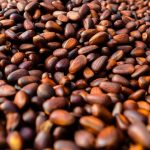Sorbic acid is an organic acid that is primarily used as an antifungal agent (Davidson, 2002), however, it also inhibits the growth of bacteria, including Salmonella. It crosses the microbial membranes to access the cytoplasm, where it acts on various proteins (Raso & Barbosa-Canovas, 2003). It is assumed that sorbic acid inhibits vegetative cells by reducing the electrochemical gradient of the cytoplasmic membrane and consequently the proton motive force. The suppression of proton motive force–related amino acid transport could eventually result in the inhibition of many of the cellular enzyme systems determining the survivability of the cell.
Maximum concentrations used in the food industry are 0.1%. Sorbic acid is preferred to other acids because of its physiological harmlessness and organoleptic neutrality (Banerjee & Sarkar, 2004).
References
Banerjee, M., and P. K. Sarkar. 2004. Antibiotic resistance and susceptibility to some food preservative measures of spoilage and pathogenic micro-organisms from spices. Food Microbiol. 21 pp. 335–342
Davidson, P. M. (2002). Control of microorganisms with chemicals, pp. 165–190. In: V. K. Juneja and J. N. Sofos (ed.), Control of Foodborne Microorganisms. Marcel Dekker, Inc., New York.
Raso, J., and G. V. Barbosa-Cánovas. (2003). Nonthermal preservation of foods using combined processing techniques. Crit. Rev. Food Sci. 43 pp. 265–285


Leave a Reply